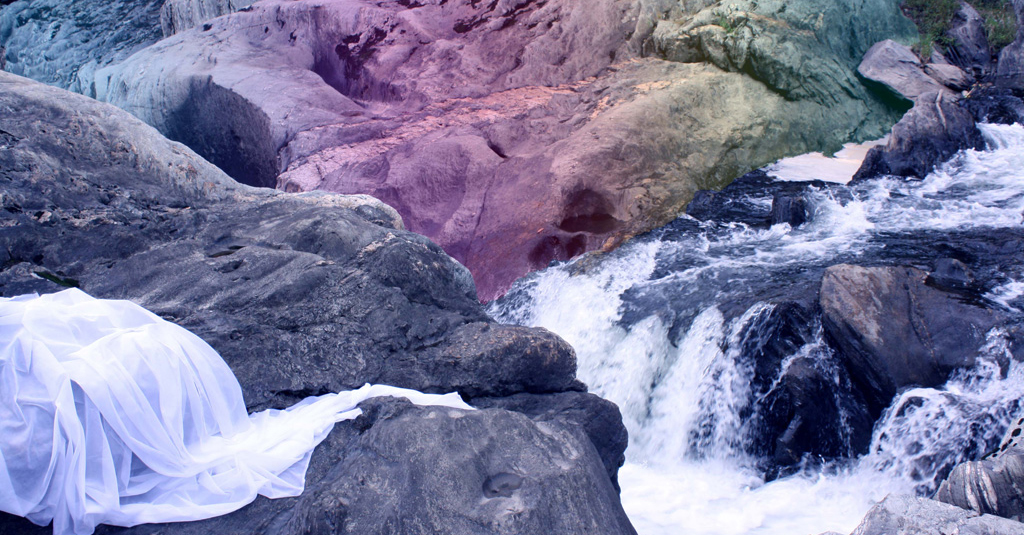The Distance Between: Stereoscopic 3D Art by Women
Participants

With Leila Sujir and Maria Lantin, Alison Loader, Emily Pelstring, Rebecca St. John
Vernissage May 17 2012
Exhibit from May 17 to June 5 2012
The Distance Between is an exhibition of 3D work by women artists working with a range of technologies, from handheld stereoscopic viewers to interactive video. Each work gives consideration to connections between the body and the virtual 3D environment, whether by inviting gestural interaction or providing immersive viewing experiences that play on our sense of scale. By presenting a variety of creative approaches made possible by the recent proliferation of stereoscopic devices for the consumer market, the exhibition seeks to encourage other artists to begin exploring the conceptual possibilities offered by these newly accessible tools.
Leila Sujir and Maria Lantin
Chorus of Lungs
3D stereographic interactive video, with Kinect for interaction; Touch Designer framework.
An exploration of elements of the social body through sound and image spatialization of voices, breath and breathing. In the installation, the lungs appear to be floating in a shared space with the viewer, with exterior spaces of pelicans in their everyday activities of flying, swimming, and eating projected onto the interior spaces of the body. Chorus of Lungs works with an ebb and flow of images, a particle-like motion simulating breathing, moving between the individual portrait to the larger grouping of the chorus, becoming a vocal conversation with the viewer, not necessarily in words. Viewers are invited to interact with the chorus through a system that invokes a fragile yet tensile strength and physicality, along with a sense of exchange and responsibility. The chorus opens and closes in response to an opening and closing of the participant’s arms (distance between hands). The breathing volume is linked to how open the chorus is. If there are two viewers, one controls the chorus and the other controls the “I like it, I don’t like it” soundtrack volume. The project explores questions of interior spaces, the body, simulation and presence.
Alison Loader
Folding
Digital Animation
Folding is a 3d animated film featuring a dance of modular origami. It was developed at the National Film Board of Canada in 2007 and completed in 2008 as a Concordia University Graduate Certificate project. Two dimensions become three as complex rigs, created in Maya, mimic paper folding and assembly. This film was originally conceived as a stereoscopic installation, viewed through a mirror assembly similar to the original stereoscope design by Sir Charles Wheatstone. The film features original sound design and composition by Luigi Allemano.
Emily Pelstring
Fairy Cam
3d photos displayed in a handheld stereo viewer
Fairy Cam is a series of 3d photos of miniature tableaus, displayed in a stereoscopic viewer. The tableaus retell the true story of two Victorian girls who steal their father’s camera, create paper-doll fairies, and take a very convincing set of photographs of themselves with the fairies. These images, known as the Cottingley Fairy photos, came to the attention of the public as documents of the supernatural in the early 1900s. Fairy Cam re-imagines a tongue-in-cheek version of history, in which the girls’ photo wins a contest for supernatural authenticity judged by a ghost.
Rebecca St. John
Rainbow Waterfall Happiness Magic
Stereoscopic Video Projection
Rainbow Waterfall Happiness Magic pays homage to Victorian postcards and early stereoscopic imagery. The piece is a self-reflective exploration of the grand romantic landscape and plays with the idea of the artificial and the natural. A moving drapery study mimics a waterfall, calling attention to the movement itself as illusion. Stereoscopic geometries and abstractions cycle through the painterly landscape, another layer of manipulation that amplifies the scene. This exhibition is made possible with support from Janro Imaging Laboratory, home of Sandde software.